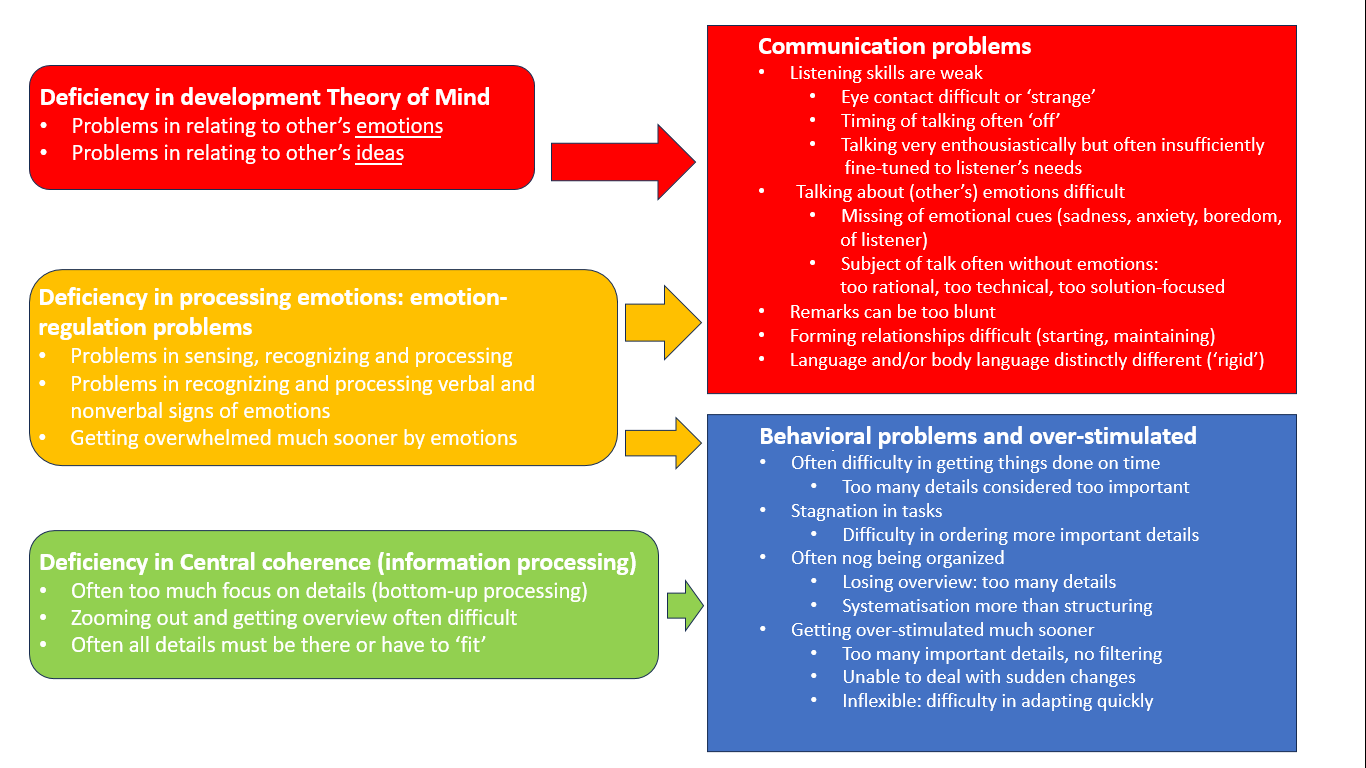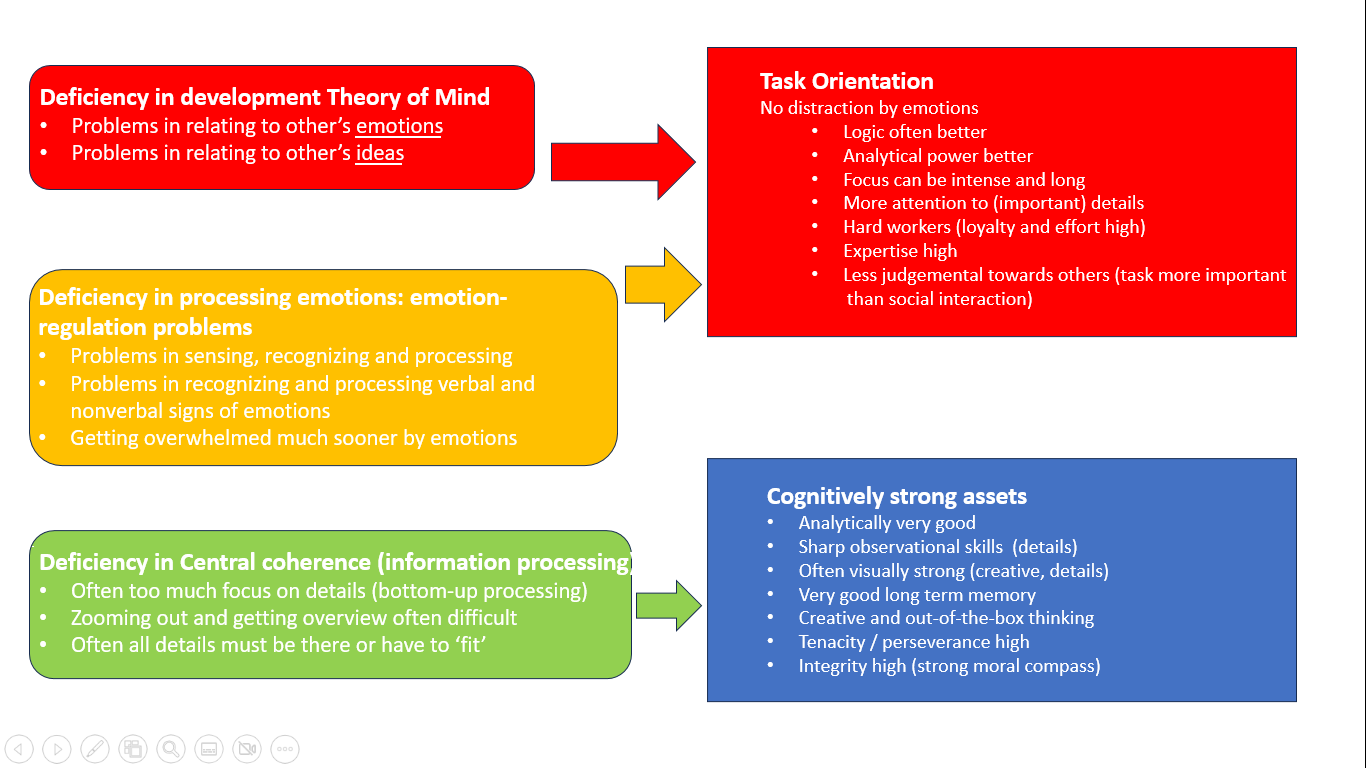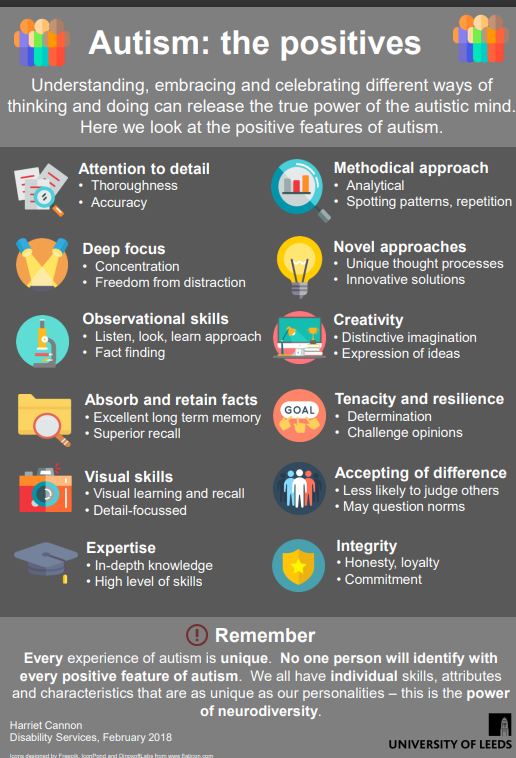- Home
- Autism
Autism Spectrum Disorder (ASD) explained: What is it ?
Ga HIER naar de Nederlandse versie van deze pagina
Below Autism Spectrum Disorder (ASD) will be explained as much as possible: the theory, the 'disorder', the symptoms, the overlap with other diagnoses, how it is diagnosed, what treatment options are available, what can be the consequences of ASD in daily life ?
I try to give as much information as possible, in a clear way. The page, of course, starts with the theory and the main symptoms. You can then look in the submenu on the right for further in-depth information (with more details) about ASD.
DSM-5 criteria for Autism spectrum disorder
According to the psychiatric manual DSM 5th version (Diagnostic and Statistical Manual of Mental Disorders), Autism Spectrum Disorder (ASD) has 2 main criteria groups: A and B.
A. Ongoing (persistent) deficiencies in social communication and social interaction, either historically or in the present day.
It therefore concerns shortcomings in contacts with other people (not with other animals). The following 3 criteria must be met:
- deficiencies in social-emotional reciprocity. That is, there are problems in sensing, starting, maintaining a normal conversation.
- deficiencies in the non-verbal communicative behavior used for social contacts/interactions.
- shortcomings in developing, maintaining and understanding relationships, both private and at work.
B. Restricted, repetitive patterns of behavior, interests, or activities, again reflected in an individual's history or present. At least 2 of the 4 criteria listed below must be met:
- Stereotypical or repetitive motor movements, or repetitive use of objects or repetitive spoken language.
- Stubborn adherence to the same behavior, pattern, situation; inflexible adherence to routines or ritualized patterns of (non)verbal behaviour
- Very limited, very fixed interests that are abnormally intense or focused.
- Over- or under-responding to sensory stimuli; or unusual interest in sensory elements of the environment.
C. The above symptoms must be present in early development/childhood.
D. The symptoms cause clinically significant distress or impairment in social, occupational, or daily life functioning.
E. The impairments are not better explained by intellectual disability or general developmental delay.
Prototypical signs of ASD in social contacts
Neuropsychologically speaking, an autism spectrum disorder has a clear cause. In the scientific literature there is still a debate about how exactly ASD can develop, but there are several ideas of what goes wrong in an autism brain.
First of all, it is essential to realize that an autistic brain (= brain that works in such a way that autism spectrum disorder is present) has problems with parts of social perception and communication. Often there are also problems in recognizing emotions or regulating one's own emotions.
For example: not being able to properly read emotions on someone's face, not being able to read your own emotions properly and therefore not someone else's, not being able to empathize with someone else, not being able to put yourself mentally and emotionally in someone else's shoes , these are all serious limitations to normal social contact. In science this is called problems in the Theory of Mind (TOM): for social interactions you must have a 'map' in your head of the emotions and thoughts of others.
People with ASD therefore often do not understand other people, their behavior, and they often do not know what to do if other people start crying, get angry or are anxious. They also often do not understand other people's jokes; they often take comments very literally, often not seeing it as a joke or as teasing.
In a conversation they often do not understand that they should not always be very honest, sometimes you just have to keep your mouth shut so that someone else does not immediately get hurt. If e.g. someone has just lost his/her father after a 6-month battle with cancer, a person with ASD may remark bluntly: "it's a pity that the suffering lasted 3 months too long". That may be technically true, but someone who has just lost his/her father like this will not be emotionally ready (if ever) for such a harsh statement at that moment. At that point more subtlety is needed, a more empathic understanding of his/her emotions. People with ASD often don't sense sufficiently these kind of emotions and can therefore come across as very blunt, very direct (while they don't mean any harm).
The ability to empathize with other people's feelings is underdeveloped in people with ASD. As a result, it is often very difficult for them to start friendships and/or relationships, but often also to maintain them for a long time. Friendships can arise, but often because there are similar interests, not so much because there is a lot of talking or sharing about emotions. Also, contact is not actively worked on if, for example, this contact was weeks ago. People with ASD usually pay little or no attention to visiting, calling or texting someone spontaneously. They often have no idea that that can also be fun for the other person. The other can therefore feel heard, valued. This is strange for a person with ASD: "I'm his friend, right? So it doesn't matter if I don't see him for weeks, right? I'm loyal and I will always be his friend."
This is not to say that people with ASD are not sensitive, have no emotions or cannot feel compassion for others at all. This is a serious misconception! People with ASD certainly have emotions, but the extent to which they can read it correctly in others, or know how to respond correctly to it, is often underdeveloped and not intuitive or automatic. Very often they have to rationalize or imitate others how to react. However, this does not mean that they cannot feel anything or that they mean wrong!
Another very clear characteristic in ASD is the failure to properly control normal eye contact. Eye contact often has to be learned because there is no proper sense of what abnormal eye contact is. For example, looking someone straight in the eye for a few seconds too long during a conversation is annoying to most people. Not looking someone in the eye too often during a conversation is just as annoying. A person with ASD often does not know how to make eye contact. The comment you often hear is that someone with ASD has learned this from others. Or they use a trick that they do not look at the eyes of the interlocutor, but only at an eyebrow, or the tip of the nose or the part exactly between the two eyes. Often the gaze of people with ASD is rather rigid, not really spontaneous.
This kind of nonverbal contact can also apply to a handshake, for example: holding a hand just a little too firmly or too long, not knowing that this is usually not experienced as pleasant.
People with ASD have to think a lot about these kinds of emotional cues and nonverbal behaviors. That is often the main reason why social contacts cost a lot of energy for them. After all, if you constantly have to think about what to do where and when in a conversation, then you are less able to keep your attention on the content of such a conversation. Or you can, but then you have to keep an eye on several things at the same time, which costs a lot of energy.
Prototypical signs of ASD in behavior and activities
In people with ASD, the powers of perception are often very well developed, but...not in the social domain. So they usually don't realize what kind of emotions and thoughts are at play in other people: a problem in forming a Theory of Mind.
But ... their perception is often very well developed in other areas. This concerns the technical aspects of their environment. They can often notice certain details much better and faster than others. For example, if a conversation partner is missing an earring, someone with ASD will notice (and often say this aloud immediately) this much faster than someone without ASD. This can also apply to a small but fine detail of a ring, for example. The attention of someone with ASD is often drawn directly to such details.
This very detailed perception of people with ASD is often very useful in certain professions. Technicians, surgeons, pilots, air traffic controllers, data typists, programmers, all professions in which details and precision work are very handy and often important, have a relatively large number of people with ASD. They may be very good at their job, but their social skills and social interactions are often quite strange, sometimes too blunt, too direct. They mean no harm but they can't be very empathetic. For example, a very clearly famous person with ASD is Sherlock Holmes (in the series in which he is played by Benedict Cumberbatch, this is portrayed very nicely): excellent as a detective but a disaster in social contacts.

Benedict Cumberbatch as Sherlock Holmes in the BBC TV-series (2010-2017). A brilliant rendition of a detective with Autism spectrum disorder.
The interests of people with ASD also often deviate from the average. Often their hobbies are more intense: for example, they collect everything about their interest, dive very deeply into it, can spend hours on end with their hobby without realizing that it is dinner time. They also find it very annoying if they are disturbed by something as trivial as a phone call or dinner. Their hobby is their everything. Everyone knows such types who have a huge LEGO collection, or a complete Train package and track system in their attic. But people with huge collections of for example dolls, stones, stuffed insects, books can also have ASD.
Finally, a third very prototypical characteristic of people with ASD is the inability to cope well with sudden changes in their patterns or environment. In the brain, this probably has a lot to do with being less able to switch between multiple thoughts (divided attention). But it seems even more likely that having to change their thought and behavior pattern produces a very strong negative emotion of fear (= loss of control) and that that is the reason for not being able to handle changes. In other words: deviation from their fixed plans is very difficult for them.
In fact, it seems to be a problem in their emotion regulation. This hypothesis is more comprehensive and also explains several problems in people with ASD. For example, they cannot remain calm in the face of intense emotions in themselves, or remain controlled. They have to respond immediately: either they get angry, or they say something directly about it, without thinking about how it comes across to others. For example, they can abruptly break off a conversation if their emotions run too high. So they are more likely to be overwhelmed by intense emotions, so more likely to be overstimulated.
People with ASD, like everyone else, have certain (unconscious) plans in their head, so how things should turn out. If reality turns out differently than they had planned (=expected), they are more likely to get upset: intense emotions that they cannot adequately regulate. Changes, especially sudden ones, are therefore very emotionally annoying for them.
Autism in a graphic model
Below you will find a handy overview of the most important characteristics of autism spectrum disorder with the negative characteristics.
Below you will find an overview of ASD with the positive characteristics

Above: Autisme spectrum disorder with the negative symptoms

Above: Autism spectrum disorder with the positive symptoms

Above is a very clear poster of the positive aspects of autism from Harriet Cannon, University of Leeds.
Differences between men and women with ASD
It is still debated whether there really are significant differences in the brains in general of men and women. If you dive into the most recent studies on this topic, it turns out that there are hardly any differences!
What I grew up with during my neuropsychology study, that there are quite a lot of differences between men's and women's brains, turns out to be NOT correct on further analysis. That's because many of the old studies were done by male researchers who had certain biases about men and women. That, for example, men have a better spatial awareness than women, turns out to be completely wrong in studies well done. For example, the idea that women are more language-skilled than men, seems to be incorrect as well. Moreover, such studies often involve averages. So you can't just say that women (which, how much, where?) are better than men (which, where, when?) at certain things.
The idea that women with Autism Spectrum Disorder are different from men with ASD cannot be maintained on the basis of more recent studies into the differences in brains between men and women.
Annelies Spek (Dutch clinical psychologist and expert in the field of ASD), Henny Struik (Dutch woman and writer with ASD), emphasize on their websites that there are indeed differences between men and women with ASD. I suspect that this is not quite correct.
The main difference lies in the researchers or therapists: they are often biased. Most therapists, psychologists and psychiatrists still have subconscious (incorrect) ideas about men and women. That causes a poorer recognition of women with Autism Spectrum Disorder. If a woman comes across as friendlier than a man, because she has learned it that way, then autism is much likely nót to be suspected in her. If a woman has pleasant and good eye contact with the researcher, the researcher will think much more quickly that there can be no question of autism. But it may certainly be the case that a woman, precisely because of her upbringing, has been pointed out much more often that she must maintain good eye contact with a conversation partner. But that does not mean that she can actually experience this eye contact as very annoying, as part of her autism.
Tests or questionnaires for Autism
This site contains a number of screeners (short questionnaires) and an extensive questionnaire for autism spectrum disorder. This latest extensive ASD questionnaire in particular clearly shows the 7 criteria of ASD in the report (as discussed above).
If you want to know if you have enough traits of Autism Spectrum Disorder, you can complete this free extensive ASD questionnaire together with someone you know well. See Autism tests for this.
Have A Great Story About This Topic?
Do you have a great story, remarks or any additions to or about this? One that could help other people as well and above all is constructive? Then please share it!
DISCLAIMER
I will not take any responsibility for how the information on this website will affect you. It always remains your responsibility to handle all information with care and in case of medical or mental problems you should ALWAYS consult a professional in your neighbourhood!
Ik neem geen enkele verantwoordelijkheid voor hoe de informatie op deze site u zal beïnvloeden. Het blijft altijd uw verantwoordelijkheid om al deze informatie zorgvuldig te bekijken. In het geval van lichamelijke en/of mentale problemen dient u ALTIJD een professional in uw directe omgeving te waarschuwen!
